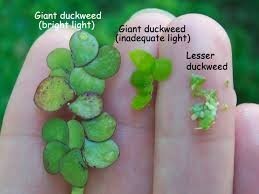
Duckweed in Aquaponics
Duckweed is an fast growing water plant that is an excellent form of fish food. Our facilities will be using this along with the worms we raise in our vermiculture beds to provide our fish an sustainable locally generated food source. The full article can be read here but for ease of access we've copied the pdf content over for you.
Duckweeds are small free-floating plants often forming dense mats on the surface of still or slow flowing water. They grow best in eutrophic (nutrient rich) waters with an element of organic enrichment from leaf litter. The leaves are small, often not exceeding 5mm in length (except Spirodela polyrhiza which can be up to 1 cm), either single (Lemna minuta and Lemna gibba) or in groups of two or three (Lemna minor). Lemna trisulca has a more complex branched structure and grows submerged. This species is not often a nuisance. The leaves of L. gibba are always swollen, whereas those of L. minor can be slightly swollen under some circumstances. L. minuta has very small leaves and short roots. The leaves of L. minuta tend to be more ellipsoidal than those of L. minor and the
plants do not stick together on the surface, behaving like individuals rather than as a mat.
The plants grow mainly by vegetative reproduction, two daughter plants bud off from the adult plant. This form of growth allows very rapid colonization of new water and re-colonization after treatment in previously infested areas. The doubling times in high summer can be as short as 2-3 days. L. minuta is becoming more prevalent as it tends to overwinter better than other species,
remaining green throughout winter.

Mechanical control
Mechanical removal is often possible in small ponds by dragging a floating boom stretched across
the pond and removing the collected mass of weed at the end of the pond. There are some
harvesting machines which will remove Lemna quite well in larger lakes. Infestation is often
prevented by stretching a boom across inflows to catch any plants coming in from upstream. It is
impossible to remove every plant by mechanical means and regrowth will be inevitable.
Mechanical methods of control give an instant effect which can last for a reasonable length of time.
The removed weed can be composted. Continuous removal of this plant is often necessary.
Chemical control
Lemna species are susceptible to herbicides containing, terbutryn and glyphosate. Clarosan
(terbutryn) is a granule formulation applied directly to the water. It will kill all submerged plants,
waterlilies are moderately resistant but may be killed if they have not been exposed to the
herbicide before. There are many formulations of glyphosate which are suitable for the control of
Lemna species, however, only formulations which state clearly on the label that they are suitable
for use in water should be used. Glyphosate formulations are applied as a spray and will only kill
plants that the spray touches (this includes water lilies and all emergent reeds, rushes and
grasses). It is not advisable to use glyphosate on thick mats of duckweed as only the top layers will
be killed and regrowth will be very rapid. However, glyphosate formulations are the best option for
single layers and small infestations.
Where dense mats are present use or Clarosan. L. minuta is
resistant to glyphosate treatment.
Use glyphosate or Reglone after mechanical treatment to kill plants left in inaccessible spots in the
margins or under trees.

Biological control
Grass carp will eat Lemna species. Further information on the use of Grass Carp for Aquatic Weed
Control is available from the Environment Agency in R&D Note 57.
Environmental control
The use of shade has been successful in reducing the amount of duckweed growth although very
deep shade is often required.
Shade can be achieved by planting trees on the south side of a waterbody. Lemna does not
compete well with other floating leaved plants such as waterlilies and planting species with floating
leaves can substantially reduce the nuisance level of duckweeds.
Duckweeds prefer still water and increasing the disturbance of the water surface can reduce the
amount of duckweed. This can be achieved by the use of a fountain or, on canals, by increasing
the amount of boat traffic. The minimum amount of boat traffic required to eliminate Lemna is
reckoned to be about 1500 boat movements per annum. Boat traffic of less than this will reduce
the competitive ability of the species and may aid in their eventual elimination.
Best option
Remove as much weed as possible by mechanical means. Spray the remainder with glyphosate if
the surface layer is thin enough, otherwise use Reglone. Spot treat any re-infestation with
glyphosate. Use Clarosan or Reglone at 25 l/ha for control of Lemna minuta.
Plant species with floating leaves to compete with the Lemna for space. Increase the disturbance
of the water surface, by installation of a fountain or recirculating pump system.
Complete control is not possible and a careful watch should be kept on regrowth from any plants
left unaffected by treatments and remedial action taken before the problem reaches nuisance
proportions.


